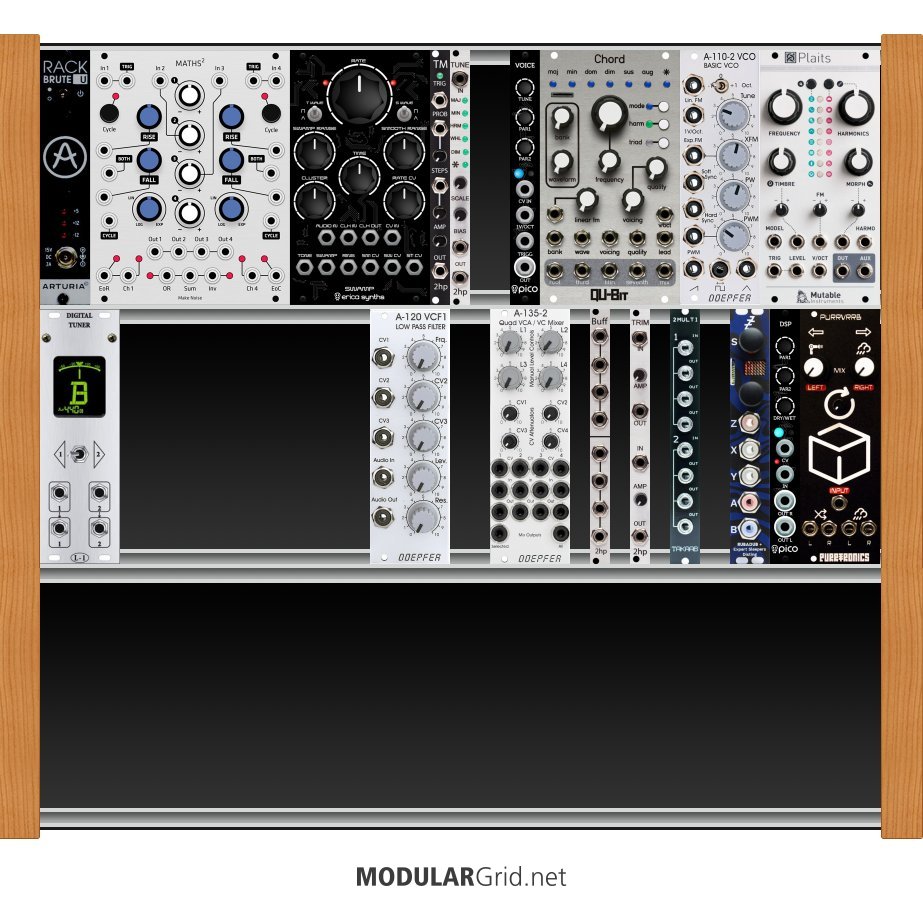The A-135-2 isn't a bad choice, although if you go with Codex Modulex's u4xVCA, you get the ability to change the VCA response from linear (which is all the A-135-2 does) to exponential, which is better for audio. Linear VCAs are much better for CV and modulation level control, where you want something with linear proportions in your level changes for scalability.
Tuner: lose it. It occupies space in the cab with a function that's better left OUTside the cab. Plus, you can do better; this L-1 module costs $95, and while it's a Eurorack module, what it really is is a remounted guitar tuner...which you can easily see from the description: "Momentary press select tunning item: Chromatic, Guitar, Bass, Violin, Ukulele. Default position is Chromatic." This isn't the right tool for electronic music instruments. Instead, spend $45 more and get this: https://www.sweetwater.com/store/detail/StroboPlusHD--peterson-sp-1-stroboplus-hd-chromatic-handheld-strobe-tuner Strobetuners have the ability to more clearly indicate tuning for microtones, they inherently function as chromatic tuners and in other temperaments (this Peterson model has 90 different tuning tables onboard). And it'll deal with a Concert A that can range from 390 - 490 Hz, as opposed to the 430 - 450 range of the L-1. I've used Strobetuners since back in my old middle school band days in the mid-1970s...they're definitely the right tool for the job here.
Now, let's actually consider how generative process composition works...
In order for this method to work well, you need to look at nested control sources. Basically, if you have some LFOs controlling pitches, then perhaps another LFO that slowly alters their rates would add to the complexity and self-regulatory aspect. And if you have that other LFO, why not add a couple of comparators to read its voltage curve levels, then the gates from those being tripped on or off can then allow other functions to be regulated...perhaps you can fire envelopes with them, or switch mixer mutes on or off, etc. We call these layers "orders of control"...the above example would actually have two orders of control, with the first being the basic LFO, then the second being both the other LFOs and comparators which then directly affect the sound production aspect of a patch.
When you start getting into third and fourth orders, especially when some of the control signals are recursive and can feed back into the lower layers, this is when you start developing a self-regulating patch. But mind you, that's A patch...not the whole thing, but just one voice. You'll want several. And some of these patches can affect others, or operate independently. When you get into this zone, then you're creating generative music. There would be no mathematical method for causing all of the layers to coincide at their respective start-points again, no matter how long the system runs. But at the same time, all of these processes are sufficiently constrained at the sound production layer so that any outcome has a specific desired sound, pitch center, mode, timbral gamut, etc.
What both Ronin and wiggler55550 appear to be getting at above is that this seems like it's a bit underequipped for serious, hardcore generative work. Trying to cram all of these self-regulated structures into a 6U RackBrute is not merely a challenge...it may in fact be nearly impossible to achieve the control density in that small a build to create these necessary orders of control. I won't say 100% impossible because there's always a way to do SOMETHING in Eurorack...but the panel density you'd have to approach would then make the whole thing a bitch-and-a-half to patch and control. You might be able to manage 1-2 of these control structures between the cab and the MB 2s, but then you'd probably have to deal with deficiencies in your sound production layer.
Ultimately, to do really effective self-regulating work like this, you need space. 2 x 88 hp just doesn't seem like enough.


